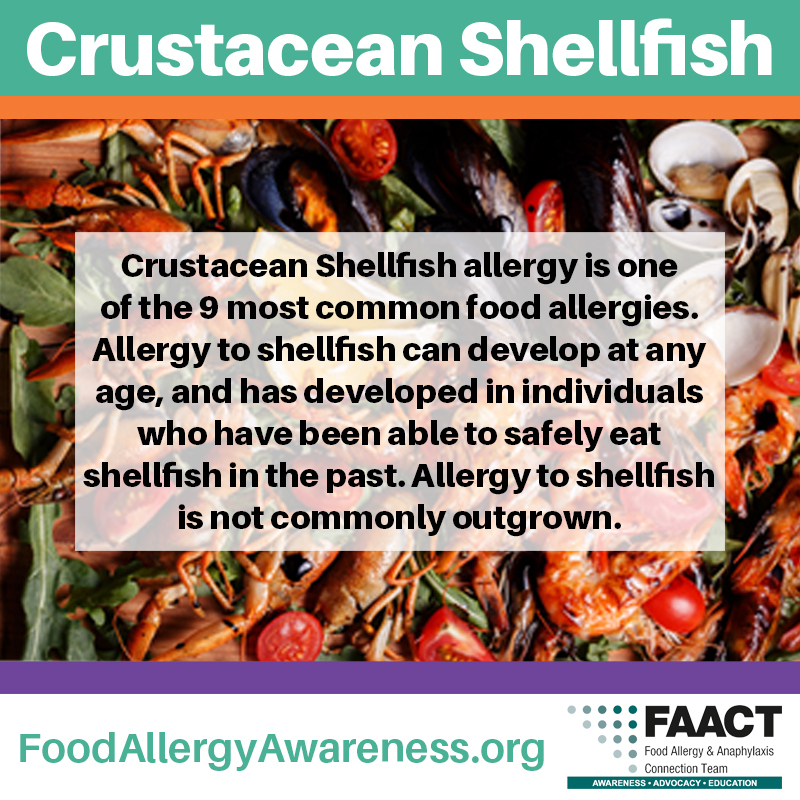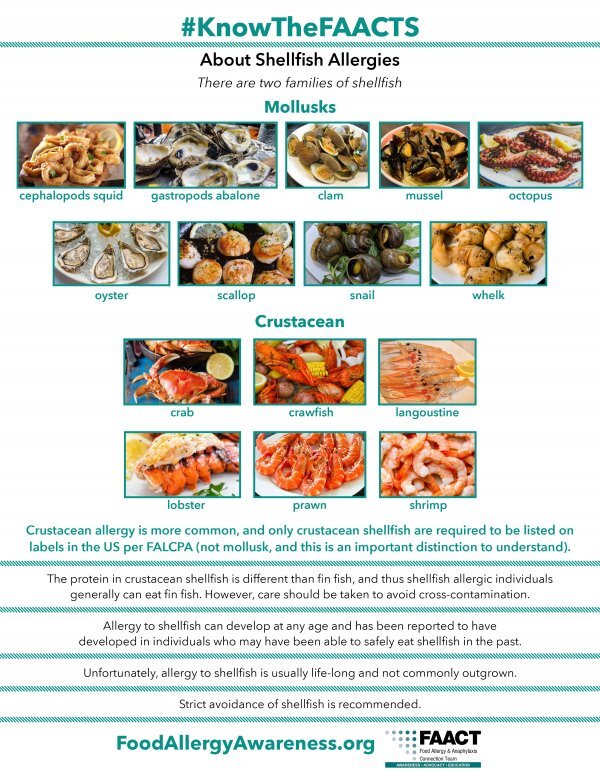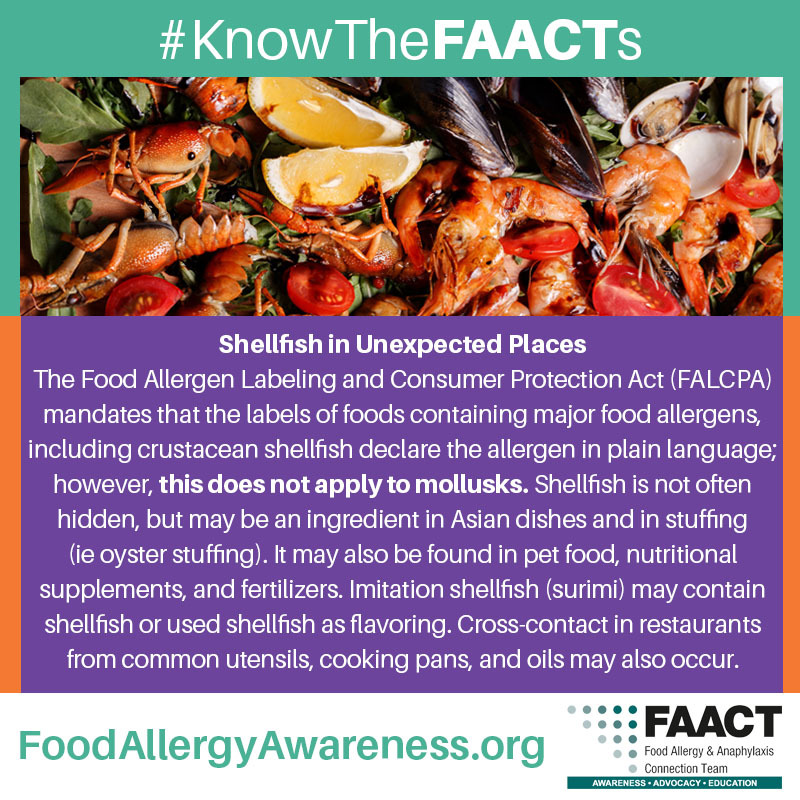Crustacean Shellfish
Subcategories

Crustacean Shellfish
Shellfish allergy is one of the most common food allergies affecting about 2% of the population according to a 2004 national telephone survey, including 2.5% of adults and 0.5% of children. More recent US estimates from 2011 noted 1.3% of children had reported shellfish allergy. Shellfish allergy is an IgE antibody-mediated reaction to proteins found in crustacean or mollusk family shellfish and is a common cause of anaphylaxis of foods. In one study reviewing causes of adult anaphylaxis, in 133 episodes of anaphylaxis 45 (34%) were stated to be due to shellfish allergy. Shellfish allergy may be most common in the Asia-Pacific region.
Allergy to shellfish can develop at any age, and has been reported to have developed in individuals who may have been able to safely eat shellfish in the past. Unfortunately, allergy to shellfish is usually life-long and not commonly outgrown. Strict avoidance of shellfish is recommended. NOTE: A shellfish allergy is different from a fish allergy. Those who are allergic to shellfish do not necessarily have to avoid fish, and vice versa.
There are two families of shellfish—mollusks (including hard shell bivalves clam, oyster, scallop, mussel; cephalopods squid, octopus; and gastropods abalone, snail, and whelk) and soft shell (arthropod crustacean species crab, lobster, prawn, shrimp, langoustine, crawfish). Crustacean shellfish allergy is more common, and only crustacean shellfish are required to be listed on labels in the US per FALCPA (not mollusk, and this is an important distinction to understand). The protein in crustacean shellfish is different than fin fish, and thus shellfish allergic individuals generally can eat fin fish. However, care should be taken to avoid cross-contamination.
Skin testing may be recommended in the evaluation of a shellfish allergy. These results must be interpreted cautiously due to the risk of cross-reactivity within the mollusk or crustacean family is common, and between dust mite and shellfish. The major protein that causes allergy in shellfish allergic individuals is called tropomyosin. This is highly shared among both species of shellfish, and also in the shells of invertebrates such as the common dust mite (which are also arthropods). Mollusks also contain other allergens such as myosin heavy chain, haemocyanin, amylase, and arginine kinase.
Tropomyosin cross-reactivity has actually caused positive crustacean shellfish allergen testing among religiously observant individuals who do not eat shellfish (e.g. Orthodox Jewish individuals). Therefore, one must be very careful not to over-interpret an isolated positive shellfish test if the history does not support a potential reaction had occurred from eating shellfish. The strength of shellfish protein cross-reactivity explains a common observation that one may test positive to multiple species within the crustacean family, or mollusk family. However, as is the case described with tree nut, some of these tests may be falsely positive, and the tests do not necessarily mean that these foods will cause a reaction. There is some risk of clinically reacting to another crustacean (or mollusk) member if there is allergy to one member, but there is less risk of clinical cross-reactivity between crustaceans and mollusks (though this still occurs in some).
In addition to skin testing and/or blood work (food specific IgE antibody) to evaluate a potential reaction to shellfish, an oral food challenge (OFC) may be necessary in some instances, as noted above. Examples of how to use OFC for evaluating shellfish allergy include making sure that a shellfish allergy can be distinguished from shellfish poisoning, to identify which particular agent a person reacts to (if the history is unclear or the person recognizes multiple shellfish), and to evaluate for exercise dependent food induced anaphylaxis. An OFC is performed in a clinical setting with a board certified allergist, which is a highly useful procedure to rule in, or rule out, the presence of a food allergy. Please consult with a board-certified allergist for further information on the diagnosis of a food allergy, or whether the allergic individual should continue to avoid shellfish.
It is also recommended, like all patients with food allergy, that individuals with food allergy have two epinephrine devices available to them at all times.
Other Sources of Protein[1]
- Meat
- Fish*
- Egg*
- Soy*
- Beans*
- Legume*
- Lentils
- Nuts
- Seeds
- Grains* (such as wheat germ, oatmeal, quinoa, and brown rice)
*It may be necessary to seek the assistance of a nutritionist to be sure the allergic individual is receiving the proper balance of amino acids.
Other Sources of Vitamin B12[2]
- Eggs*
- Fortified Foods
- Meat
- Organ Meats (liver and kidney)
- Poultry
*Be aware these are the most common allergenic foods. However, almost any food can cause an allergic reaction. It is recommended to speak with a board certified allergist before adding any new foods to the allergic individual’s diet.
Practical Tips
Read all product labels prior to the consumption of a new food product. According to the Food Allergen Labeling and Consumer Protection Act (FALCPA), food products with the advisory statements such as “may contain” or “manufactured in facility that process” on a package are voluntary. These statements are one in the same and manufacturers are not required to include these advisory statements. Whether or not the statement appears on a product has no baring on the safety. The absence of the statement does not necessarily mean that products may have not been exposed to cross-contact. Cross-contact is when a food item has been manufactured on a shared equipment with an allergen. It's recommended that you contact the manufacturer and ask specific questions about a product to confirm its safety. Foods labeled as "kosher" will not contain any shellfish products.
Cross-contact (sometimes referred to as cross-contamination) occurs when the protein from a food one is allergic to contaminates a normally safe food. This can happen during preparation, cooking, or serving. Due to the risk of cross-contact individuals with a shellfish allergy may wish to avoid seafood restaurants or those that offer dishes made with shellfish. For example, pans used to make a shrimp scampi dish that are not carefully cleaned with soap and hot water could potentially transfer shrimp to another dish. As well, shrimp or other shellfish simply cannot be “removed” from a salad and the same salad re-served—that dish is contaminated. Be careful with laminated menus, surfaces, reusable place-settings, and on-table condiments at restaurants that serve shellfish that could be touched and contaminated, and then not washed. As always, clear communication with restaurant staff is key to avoid a reaction caused by cross-contact. Such individuals must also be very careful when ordering fish from a fish market to avoid the risk of contamination in the display and packaging.

AVOID foods that contain or may contain shellfish ingredients:
The following is a list of words that indicate, or might indicate the presence of shellfish. Shellfish actually contains two categories of food, crustaceans and mollusks:
Crustacean:
- Barnacle
- Crab
- Crawfish (crayfish, ecrevisse)
- Krill
- Lobster (langouste, langousine, scampi, coral, tomalley)
- Prawns
- Shrimp (crevette, scampi)
Mollusks:
- Abalone
- Clams (cherrystone, littleneck, pismo, quahog)
- Cockle (periwinkle, sea urchin)
- Mollusks
- Mussels
- Octopus
- Oysters
- Scallops
- Snails (escargot)
- Squid (calamari)
Other foods that may contain shellfish:
- Bouillabaisse
- Fish Stock
- Seafood Flavorings (such as crab, clam extract)
- Surimi

Shellfish in Unexpected Places*
The Food Allergen Labeling and Consumer Protection Act (FALCPA) mandates that the labels of foods containing major food allergens, including crustacean shellfish declare the allergen in plain language; however, this does not apply to mollusks.
Shellfish is not often hidden, but may be an ingredient in certain dishes and in stuffing (ie oyster stuffing). It may also be found in pet food, nutritional supplements, and fertilizers. Imitation shellfish (surimi) may contain shellfish or used shellfish as flavoring. Cross-contact, as mentioned earlier, in restaurants from common utensils, cooking pans and oils may also occur.
NOTE: Please keep in mind in a culturally diverse world, different ingredients may be used in different recipes. Always use extreme caution.
Other pages that may be of interest:
Visit FAACT's “CROSS-CONTACT” page to review how to properly clean allergens from hands and surfaces.
FAACT
Did you know that people who are allergic to shellfish are NOT at any increased risk of allergic reactions to iodine or radiocontrast media? This is one of the largest myths that still persist, costing the healthcare system millions of dollars.
It is rare, but possible, for aerosolized shellfish allergen, to cause symptoms. This can happen from cooking and smelling vapors, or from restaurant workers or shellfish processers with frequent close exposure to these items.
References
[1] NLM/NIH MedlinePlus http://www.nlm.nih.gov/medlineplus/ency/article/002467.htm
[2] NLM/NIH MedlinePlus http://www.nlm.nih.gov/medlineplus/ency/article/002403.htm
Debunking myths about "allergy" to radiocontrast media in an academic institution. 2015 Apr;127(3):295-300. doi: 10.1080/00325481.2015.1012918. Epub 2015 Mar 5. https://pubmed.ncbi.nlm.nih.gov/25740573/
The relationship of radiocontrast, iodine, and seafood allergies: a medical myth exposed. J Emerg Med. 2010 Nov; 39(5):701-7. doi: 10.1016/j.jemermed.2009.10.014. Epub 2010 Jan 4. https://pubmed.ncbi.nlm.nih.gov/20045605/
Airborne seafood allergens as a cause of occupational allergy and asthma. Lopata AL, Jeebhay MF. Curr Allergy Asthma Rep. 2013 Jun;13(3):288-97. doi: 10.1007/s11882-013-0347-y. https://pubmed.ncbi.nlm.nih.gov/23575656/
Griffin P, Allan L, Gibson M, Elms J, Wiley K, Curran AD. Measurement of personal exposure to aerosols of Nephrops norvegicus (scampi) using a monoclonal-based assay. Clin Exp Allergy. 2001 Jun;31(6):928-33. https://onlinelibrary.wiley.com/doi/10.1046/j.1365-2222.2001.01100.x?msockid=3ef6692a04f26d35246f7c7805936ce9
Relevant Citations
Lopata Al, Oheihir RE, Lehrer SB. Shellfish Allergy. Clin Exp Allergy 2010; 40: 850-58.
Sicherer SH, Munoz-Furlong A, Sampson HA. Prevalence of seafood allergy in the United States determined by a random telephone survey. J Allergy Clin Immunol 2004; 114:159–65.
Lau Ch, Springston EE, Smith B, Pongracic J, Holl JL, Gupta RS. Parent report of childhood shellfish allergy in the United States. Allergy Asthma Proc 2012; 33: 474-80.

